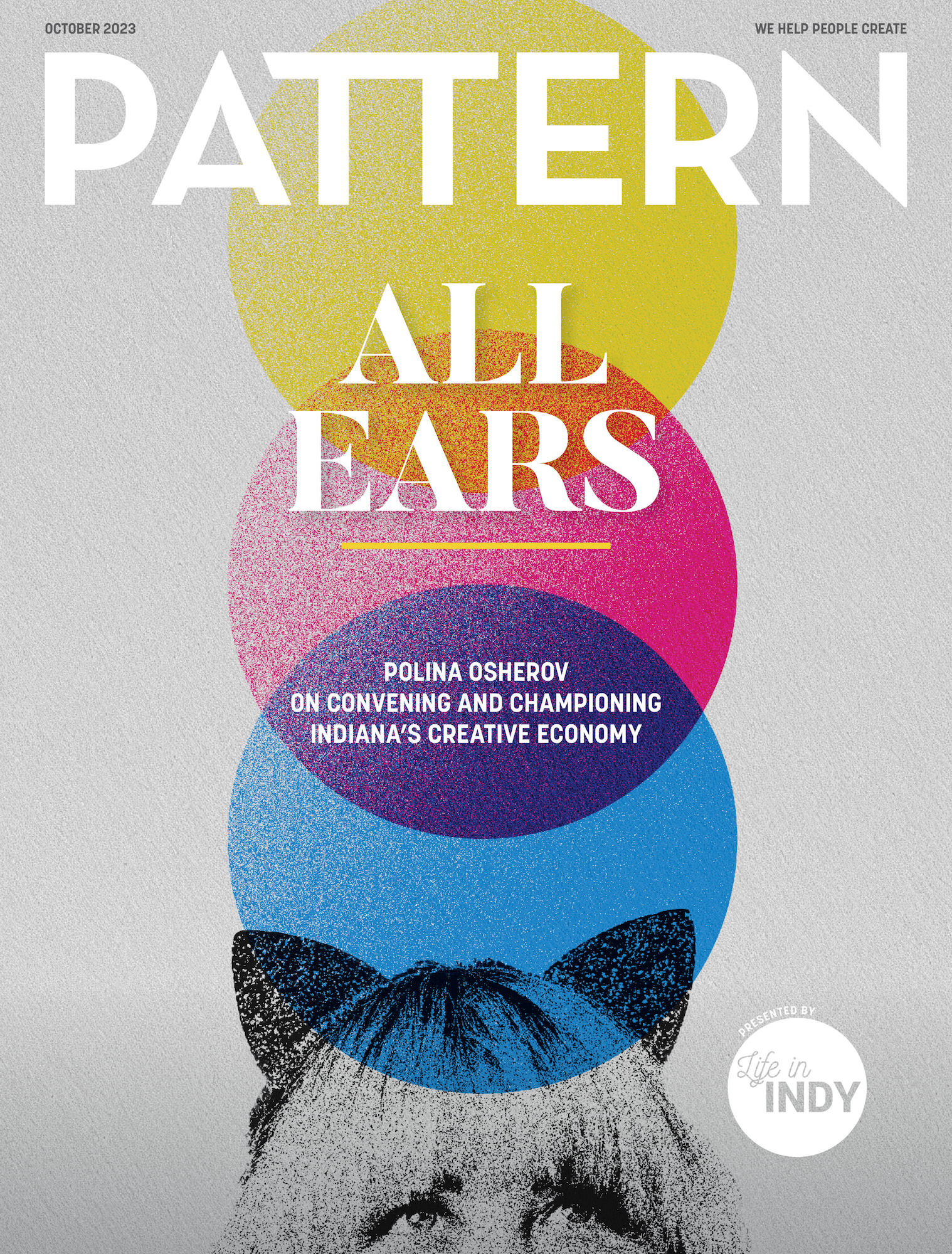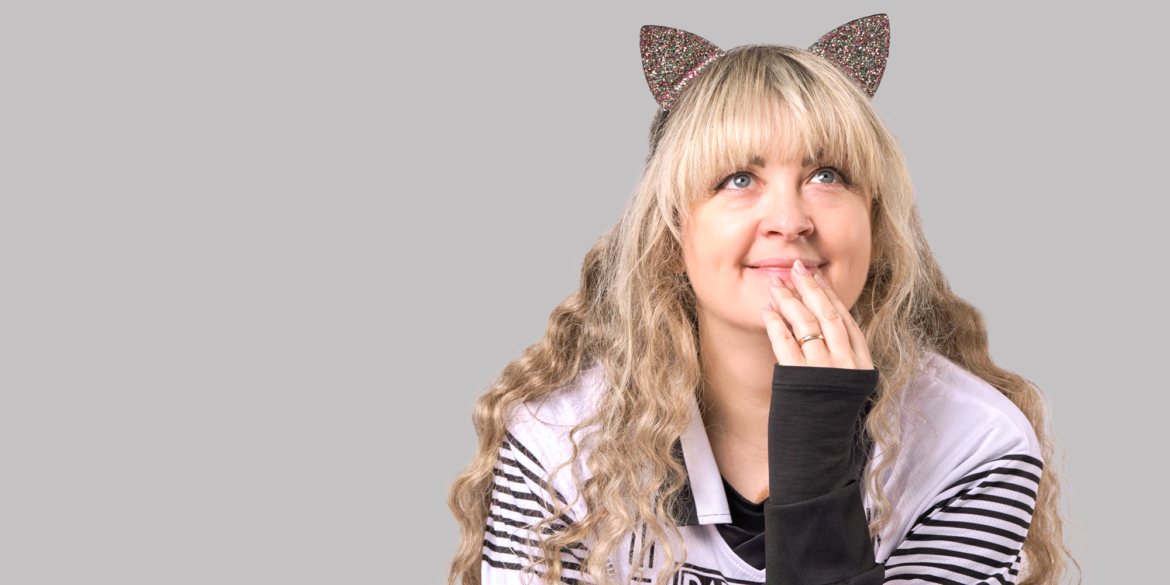Polina Osherov is one of Indiana’s most committed champions, but many of you already know Indiana isn’t where she started. Born in Moscow, Russia, Osherov made her way to the U.S. by way of Italy and Australia with her parents and landed in Indiana after first spending some years in Chicago. But talk to her for three minutes, and you’ll know that she’s made short work of connecting to what Indiana has to offer. After decades of working in Indy’s various creative communities as a professional photographer and through PATTERN, she has become intimately familiar with the opportunities and challenges of participating in Indiana’s creative economy–both her own and others. I imagine I’m not the only one who wants to know more.
Casey Harrison: All right, so obviously, we have to talk about the cat ears.
Polina Osherov: (Laughing.) What’s dumb is that I don’t really like cats. I picked up my first pair of cat ears on a whim from Urban Outfitters. Not the store you really plan to find your personal brand . . . but here we are. I wore them to Paris Fashion Week and people loved them. Everyone was smiling and engaging with me even though we spoke different languages. It was a little addicting, so the ears stuck. Who knows how long they’ll last though, I might be ready for a change.
CH: That sounds like a longer story. But we’ll save it for another time. Before we dive into the heart of this conversation, will you give us a quick lesson on the term creative economy? What sectors does it include?
PO: Sure! As a term, the creative economy is relatively new. While the practice is about as old as you can make one, the term started gaining widespread recognition twenty-some years ago when John Howkins published The Creative Economy: How People Make Money from Ideas. This concept has had more traction internationally than in the United States, and then more so in coastal markets than the Midwest. But we are currently in the process of catching up to fully embrace and integrate the creative economy, which in many ways is a vague identifier for the various industries and jobs that leverage creativity and innovation. The creative economy encompasses fashion, film, advertising, nonprofit arts, and merchandising, among many other industries.

CH: Okay, so based on the work PATTERN is doing now (e.g. Creative Crossroads: Indiana’s Creative Economy Summit), we can assume you’ve moved beyond your roots in fashion to something that more broadly encompasses creative entrepreneurship, is that right?
PO: Right. I got into this work because of my love for fashion photography. I particularly like the group dynamic of those projects–you have models, stylists, hair and makeup artists, set designers, assistants, not to mention the photographers. It’s quite a crew, and it’s a lot of natural cross-pollination.
When PATTERN began as a meetup thirteen years ago, it attracted a lot of enthusiastic and energetic individuals who were eager to learn from one another and connect with like-minded people. Think photographers, graphic designers, writers, and designers. These folks were having similar challenges trying to make a go of their creative professions.
Certainly, traditional resources were available through the Small Business Administration (SBA), but these pathways aren’t designed for creative mindset and their specific needs. I think PATTERN’s success and rapid growth were a result of listening and then filling this gap in the creative community.
CH: I love it. You’ve obviously been really close to the ground when it comes to the creative economy then, at least as it’s been playing out in Indy. What are some moments when you feel that Indiana rallied in support of our creatives?
PO: Is it bad that I’m reaching back to 2012? Because when Indy hosted Super Bowl XLVI, our city really shined–and so much of that success was obviously due to the participation of our creative entrepreneurs. We saw intentional investments by our corporate and philanthropic community members into our creative entrepreneurs, enabling them to create without constraint–and we got these incredible experiences like Super Bowl Town, immersive downtown art exhibits, and so many music activations. The result was undeniable.
The city galvanized and mobilized creative entrepreneurs, and those creatives made Indy look great for the rest of the world. These investments led to a sense of statewide pride and a buzz of momentum in addition to unprecedented tourism traffic and economic impact for restaurants, entertainment venues, hotels, and beyond.
But a creative movement in response to the Covid pandemic was also impressive. Just a couple of weeks into the shutdown, the Indy Arts Council stepped in and led the charge in identifying revenue streams to support artists, art organizations, and the for-profit arts community. All said, they administered close to $24 million between 2020 and 2021. Once we got through the pandemic, we saw a swell of artistic activity and creativity with funds that enabled Indy to keep creating as a form of expression, processing, and healing during times of unprecedented uncertainty. Their work with those investments quite literally provided so that artists could keep creating.
CH: You’ve provided great proof of concept here. Indy clearly knows how to engage our creative entrepreneurs when we’re on a national stage and when things hit the fan. But am I wrong to say it doesn’t seem like we can maintain this kind of progress beyond outlier moments in time? What are you hearing from creatives about this?
PO: Indiana has the assets in droves. We have incredibly smart, talented, creative people who want to live here to keep creating. But we lack an infrastructure that expedites those individuals from ideation to monetization in a way that enables them to continue growing and scaling their art, impact, and opportunities. We often lose creatives to other parts of the world where they can more quickly and easily plug into an infrastructure that enables them to realize greater success faster.
We see this reality play out over and over with our past interns and creative fellows. It’s disappointing because they really come to love Indiana as they spend time with us, but once our time is up, they find themselves needing to look elsewhere to really start their careers.
To get back to your question, though, I think Indiana has proven to be efficient with complex issues. The entrepreneurial ecosystem development initiatives led by IEDC is a great, recent example of that. But I wonder about how we’re using the term innovation, and it’s my opinion that we need to start thinking beyond traditional economic development frameworks. This is where the role of creatives and creativity becomes critical.
We’re navigating a world that’s rapidly transforming and creatives bring fresh perspectives and problem-solving approaches that can redefine how we manufacture, how we engage with technology, and even how we envision communities and human potential. By integrating creative thinking into our economic strategies, we’re not just adapting; we’re setting the stage for exponential economic growth and opportunities.
CH: We’ve been talking a lot about the creative economy, which I get the sense is what you prefer to talk about. But rumor has it that you’re particularly good at providing advice to creative folks who are just starting to make their way in the world. Would you be willing to share some of your most universally applicable advice here to close us out?
PO: I think the key to an engaging life is to stay curious and go after what genuinely interests you. A lot of folks get stuck in their comfort zones due to fear or inertia, missing out on transformative experiences that often lie just outside what’s familiar.
The saying goes, “If your dreams don’t scare you, they’re not big enough.” There’s something to that. Trying to be what others want you to be is a dead end; focus on being the best version of yourself. That involves knowing your strengths and weaknesses and leveraging them to lead a life that’s rewarding in its own right.
And about the money? Sure, it’s great, but it’s not the end-all-be-all. Plenty of wealthy people are unhappy, so it’s essential to find contentment in simplicity. If you can be happy without chasing wealth, you’re already ahead of the game. Even if you do find financial success, it’ll be a bonus, not a crutch for happiness.




